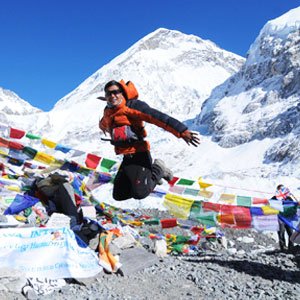The Great Himalayan Trail is a long-distance footpath that runs from Kanchenjunga in the east to Darchula in the west, offering an extraordinary diversity of landscapes, cultures, and experiences. After completing both the Annapurna Circuit Trek and the Everest Base Camp trek, Moon Seung Young felt these commercial and meticulously organized treks rarely gave her the freedom to explore nature and learn new things about Nepal. Dissatisfied, Moon began looking for alternatives, new trails to the remotest parts of Nepal that gave her the opportunity to explore uncharted territories, and that is how she stumbled upon the Great Himalayan Trail in 2013. (Soon she would go on to become the first South Korean to complete the Great Himalayan trail high route.)
Giving experienced trekkers this unique opportunity was precisely the idea behind the Great Himalayan trail, which was launched in 2009 after five years of meticulous research, documentation, and mapping. In the same year, Robin Boustead led the first team to complete the whole trial, in 162 days. The GHT is a long-distance footpath that runs from Kanchenjunga in the east to Darchula in the west, covering 1,700km and offering an extraordinary diversity of landscapes, cultures, and experiences. The whole trek takes around 150 days to complete. On the way, trekkers walk through eight of the world’s 14 peaks over 8,000m, and cross passes at an altitude of up to 6,000m. Covering regions like Annapurna, Sagarmatha, Dolpa, Manaslu, and Langtang, the goal is to get a new generation of trekkers excited and get them exploring Nepal.
Routes
There are two routes that the Great Himalayan trail trekkers can take the high route and the low route. The former (3,000-6,000m) passes through some of the most remote villages and high-altitude valleys of Nepal. The latter has an average altitude of 2,000m, the highest point being the Jang La pass (4,519m). Taking around 95 days to complete, trekking along it means walking through dense forests and small communities and learning about their customs and religions.
Difficulties
Completing the Great Himalayan trails is considered far more difficult than climbing a mountain, as it calls for a very high level of fitness and commitment. Only a few as such have completed the high route."You must have three things time, money, and courage to complete the Great Himalayan trail” says Nima Dawa Sherpa, a Nepali trekker who completed the high route in a record 82 days. “Not everyone has all three at once. Trekkers don’t get to see human habitats for two or three days in a row and they have to carry basic items like food and tents themselves.”When we crossed the trail, passes were very narrow in some places, so we could only set up one tent and as many as 11 people had to sleep in it,” says Moon Seung Young. “And there were no good signposts to guide us.”
Setback
The concept was based on a business model specifically drafted to benefit Nepal’s tourism,” says Pranil Upadhyaya, a certified trail manager. “But as the trail passes mostly through the wilderness, it couldn’t generate much business. Plus, the rigor of the trek dissuaded many.”
As such, the GHT was subsequently divided into a 10-part network of trails, which includes Kanchanjunga, Makalu-Barun, Everest-Rolwaling, Helambu-Langtang, Ganesh Himal-Manaslu, Annapurna and Mustang, Dolpa, Jumla, Humla, and the far-west. As it takes only around two to three weeks to complete one sector, more people got interested.
Even so, Upadhyaya adds, Nepal’s trails are not up to international standards. Four basic aspects of a trail are safety, environment, boarding facilities, and information in the form of signposts. Most Nepali trails lack one or more of these. He is not pessimistic though. “For the first time, we are getting trail standard guidelines in Nepal, and under the Tourism Ministry, a trail standard community has been formed,” Upadhyaya says. “The standard of Nepal’s trails is being gradually improved with the collaboration of various national and international bodies”




